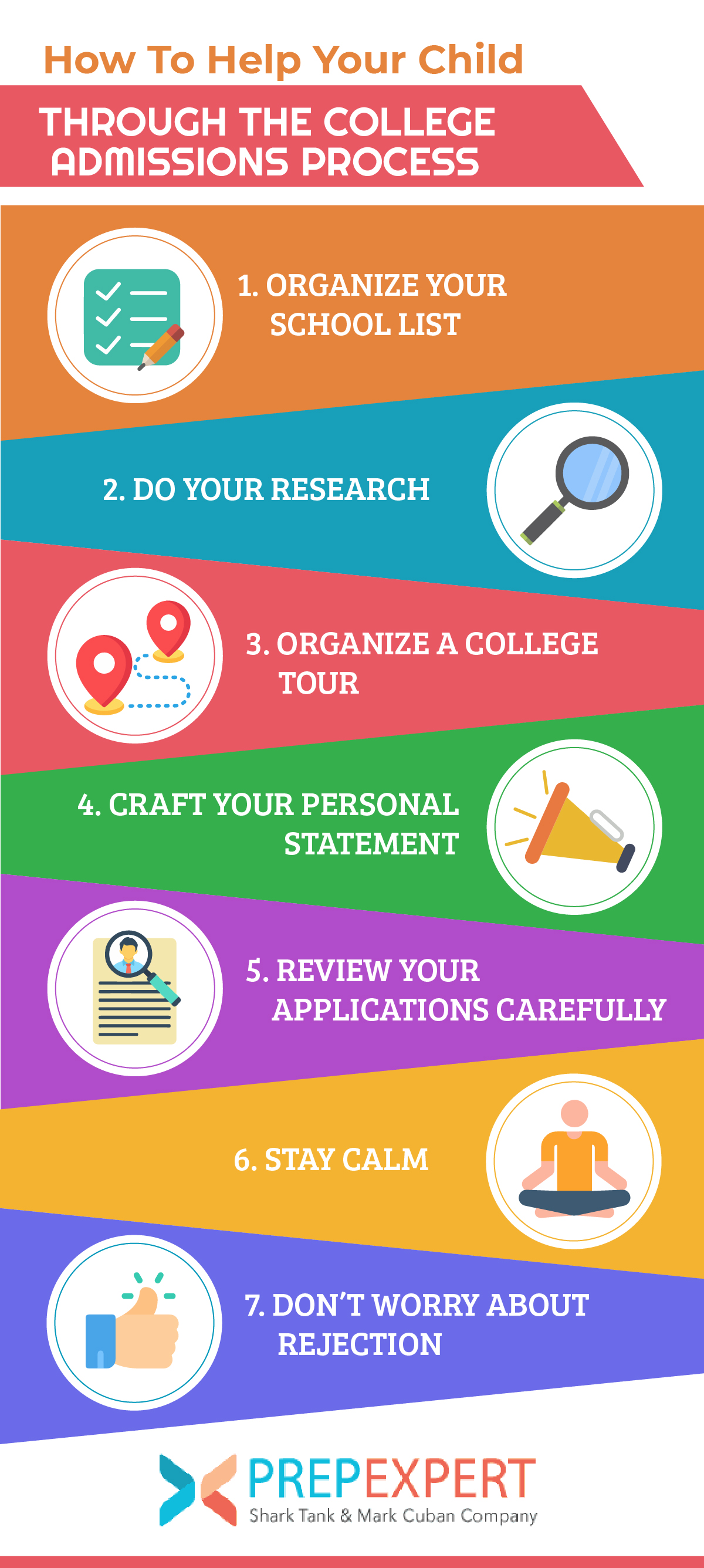How To Help Your Child Through The College Admissions Process
The college admissions process is incredibly stressful for students (as well as parents!). But, there are plenty of things you, as a parent, can do to make the process go smoothly, and boost your child’s chances of ending up at his or her dream school.
A smart and savvy college admissions plan includes creating an effective system to keep track of admissions requirements and deadlines; doing research (both online and in-person) over admissions requirements and determine if schools are good fits; writing a personal statement, and paying attention to detail before submitting applications.
Throughout the process (especially if rejections arrive), do your best to keep your student de-stressed, and remind him or her that where you go does not define who you are.
The steps below are meant to guide you and your child through the college admissions process. And remember, Prep Expert®’s SAT prep courses and ACT prep courses are a great way to improve your student’s standardized test scores and broaden his or her college options.


First Things First, Get Organized
Sit down with your child and draw up a list of schools he or she wants to apply to first and foremost.
Be sure to include at least three safety schools, three right-on-target schools, and two or three reaches. Then, create a spreadsheet to track everything—application deadlines, fees, required essays and standardized test scores, etc.
Google Drive is a good place to organize your child’s college admissions process. Drive allows you to share files (such as personal statement drafts) and update the admissions spreadsheet together as you go. In addition, Google Calendar allows you to create alerts to remind you and your child about upcoming deadlines and standardized test dates.
[leadmagnet_five]
There are plenty of other resources, such as Microsoft Office, to get you and your child organized. The important thing is for you to create an easy-to-access system to keep on track and on top the many details of the college admissions process.

Do Your Research
After you’ve set up a system to keep yourself organized, get on your colleges’ admissions websites and find out all the information you and your student need to stay on top of immediately.
This includes application deadlines, admissions fees, standardized test requirements (typically, ACT or SAT and a few SAT Subject Tests), required essays, etc. You should also research the colleges more in-depth to ensure they are the right fits for your child.
Most colleges and universities have Early Admission deadlines in November and Regular Admission deadlines in January. Many colleges have deadlines on the same dates, but double-check each one just to be sure.
Additionally, most colleges and universities use the Common Application, which simplifies the admissions process tremendously. The Common Application allows your student to fill out a single application for multiple colleges all at once. However, be aware that some colleges don’t use the Common App, and many have additional essays or questions your student will need to answer.

Organize A College Tour
There is no better way to determine if a college or university would be a right fit for your child than to go and visit the campus.
Talk to students and get a taste of what life at the school is like. Organize a trip in the spring of junior year, and visit schools with your student. It will be a chance to spend time with your child and allow him or her to check in with the admissions office.
When doing your research, check if any of the prospective school have has a weekend designed for prospective students. Although you can visit the schools anytime, prospective students weekends are especially good times to visit.
Student ambassadors will be present to answer your questions and provide tours of the campus, and there will be events focused on showcasing the school and answering questions about matters such as academics, financial aid, and housing.
Things you will want to ask about on your college tour about are academics, student housing (whether it is guaranteed, and if so, for how many years), financial aid, resources available to students, and student life in general. Be sure to talk to students and ask them about their experiences on campus.
In addition, check in with your student to see how he or she is feeling about each school as you visit. There’s a chance your child might have second thoughts about applying after the trip. Use these changes of mind as opportunities to discuss what your child is looking for specifically, and adjust the college list if necessary.

Encourage Self-Evaluation & Storytelling In The Personal Statement
The personal statement is your child’s opportunity to showcase him or herself.
Admissions officers read thousands of personal statements every year. To stand out, your student should tell a story about a challenge he or she overcame, and how the experience shaped him or her personally. Remember “show, don’t tell”—for example, your child should cite examples of charity or teamwork, rather than simply stating he or she is charitable or a team player.
It would be useful to sit down with your child and talk about his or her experiences in life, and come up with a few different ideas about what to write about. After this brainstorming process, your student can take a few passes at writing before finding the right topic. Give your child feedback as he or she writes drafts of the statement and perfects it.
Remember that a good personal statement is free of cliches and predictable topics, self-aware, and well-written. As with the rest of the application, the final product should be looked over a few times to make sure it is free of errors.

Time To Submit—Pull Out That Fine Toothed Comb & Ensure Everything Is Spotless
When it comes time to submit applications, review all of your child’s materials carefully.
Look out for errors, such as mentioning the wrong school in a personal statement, or forgetting to answer a school’s supplemental questions. In addition to you and your student, another set of eyes—those of a spouse, a sibling, a guidance counselor—will be useful here.
Be sure to submit all applications on time. Extensions are sometimes granted, but won’t reflect well on the application. Your application spreadsheet and calendar will help prevent this.

It’s Time To Wait—Keep Your Student De-stressed
Early Decision notifications arrive in November, and Regular Decision notifications arrive around the beginning of April. Do your best to alleviate the inevitable stress your student will be feeling during this time.
Whether through encouragement, organizing a fun activity or trip, or using tried-and-true de-stressing methods, such as yoga or meditation, find activities to help them de-stress while waiting. When decisions arrive, your student might be admitted to his or her dream school and feel exultant.
Or, a rejection or waitlist might arrive, leaving your student feeling disappointed, depressed, or angry. These negative feelings will be especially exacerbated if classmates and friends are accepted to schools your child isn’t.
This is where our last piece of advice comes in.

It’s Time For A Reality Check—Where You Go Is Not Who You Are
Remind your student that rejection is not the end of the world. Where you go to college does not define who you are.
Countless successful people have gone to lesser known schools, or dropped out, or didn’t go to college at all. Give your child some perspective, and remind him or her that the future is still limitless.
If your student is waitlisted at a school, work with him or her to send the college an updated high school transcript, and also to write a letter indicating continuing interest in the school. Although there are no guarantees, some schools do accept a significant number of applicants off their waitlists.
[leadmagnet_two]
Also, remind your student that the college he or she does attend might turn out to be a great fit. And, if he or she wants to, there is always the option of submitting a transfer application after freshman year.

Remember: Prep Expert® Can Help Your Student Achieve A Higher Score
If you’re still early on in the college admissions process and your student has yet to take the SAT or ACT, then consider a test-prep course or signing up for one-on-one tutoring.
Prep Expert®’s strategies have helped countless students increase their scores and go on to the colleges and universities of their dreams.
Classes and tutoring are offered in cities throughout the country, as well as online. In addition, online classes can be watched On-Demand, so if your student can’t make a class, or wants to watch at a different time, he or she can.
Check out our website Prep Expert for more details. And if your student has already been admitted into their desired school, check out this great article Admission Deadlines Are Out: Now What? We wish the best of luck to you and your student throughout the college admissions process!
For more test strategy, college admissions, and scholarship application tips sign up for our FREE class happening right now!
Written by Dr. Shaan Patel MD MBA
Prep Expert Founder & CEO
Shark Tank Winner, Perfect SAT Scorer, Dermatologist, & #1 Bestselling AuthorMore from Dr. Shaan Patel MD MBA

How Prep Expert® Students Achieve Life-Changing ACT & SAT Score Improvements
For thousands of students, the SAT or ACT isn’t just a test — it’s a turning point. A higher score…

How to Get a Good ACT Score
Getting a good ACT score can feel a little mystifying to some students. After all, with the big numbers the…

Tens of Thousands Are Sitting for the SAT—But Only the Savvy Ones See a Massive Opportunity
Why Tens of Thousands of Students Taking the SAT Right Now Should See It as an OpportunityBy Dr. Shaan…